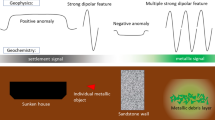Abstract
Site characterization activities at potential unexploded ordnance (UXO) sites rely on sparse sampling collected as geophysical surveys along strip transects. From these samples, the locations of target areas, those regions on the site where the geophysical anomaly density is significantly above the background density, must be identified. A target area detection approach using a hidden Markov model (HMM) is developed here. HMM’s use stationary transition probabilities from one state to another for steps between adjacent locations as well as the probability of any particular observation occurring given each possible underlying state. The approach developed here identifies the transition probabilities directly from the conceptual site model (CSM) created as part of the UXO site characterization process. A series of simulations examine the ability of the HMM approach to simultaneously determine the target area locations within each transect and to estimate the unknown anomaly intensity within the identified target area. The HMM results are compared to those obtained using a simpler target detection approach that considers the background anomaly density to be defined by a Poisson distribution and each location to be independent of any adjacent location. Results show that the HMM approach is capable of accurately identifying the target locations with limited false positive identifications when both the background and target are intensities are known. The HMM approach is relatively robust to changes in the initial estimate of the target anomaly intensity and is capable of identifying target locations and the corresponding target anomaly intensity when this intensity is approximately 60% higher than the background intensity at intensities that are representative of actual field sites. Application to data collected from a wide area assessment field site show that the HMM approach identifies the area of the site with elevated anomaly intensity with few false positives. This field site application also shows that the HMM results are relatively robust to changes in the transect width.







Similar content being viewed by others
References
Allard D, Fraley C (1997) Non-parametric maximum likelihood estimation of features in spatial point processes using Voronoi tessellation. J Am Stat Assoc 92:1485–1493
Byers S, Raftery AE (1998) Nearest-neighbor clutter removal for estimating features in spatial point processes. J Am Stat Assoc 93:577–584
Carle SF, Fogg GE (1996) Transition probability-based indicator geostatistics. Math Geol 28(4):453–477
Carr DD, Horowitz A, Hrarbar SV, Ridge KF, Rooney R, Straw WT, Webb W, Potter PE (1966) Stratigraphic sections, bedding sequences, and random processes. Science 28(3753):89–110
Catana AJ (1963) The wandering quarter method of estimating population density. Ecology 44(2):349–360
Coburn T, McKenna SA, Saito H, Garcia OT (2008) Strip transect sampling to estimate object abundance in homogeneous and non-homogeneous Poisson fields: a simulation study of the effects of changing transect width and number. In: IAMG Monograph in Honor of Frits Agterberg, Bonham—Carter (ed) (in press)
Cowling A (1998) Spatial methods for line transect surveys. Biometrics 54:27–38
Diggle PJ (2003) Statistical analysis of spatial point patterns, 2nd edn. Oxford University Press, New York, 159 pp
Doll WE, Gamey TJ, Beard LP, Bell DT, Hollady JS (2003) Recent advances in airborne survey technology yield performance approaching ground-based surveys. Leading Edge 22:420–425. doi:10.1190/1.1579574
Doveton JH (1994) Theory and applications of vertical variability measures from Markov chain analysis. In: Yarus JM, Chambers RL (eds) Stochastic modeling and geostatistics: principles, methods and case studies, AAPG computer applications in geology, Chap 6, vol 3. AAPG, Tulsa, pp 55–64
Duda RO, Hart PE, Stork DG (2001) Pattern classification, 2nd edn. Wiley, New York, 654 pp
Elfeki A, Dekking M (2001) A Markov chain model for subsurface characterization: theory and applications. Math Geol 33(5):569–589
Hedley SL, Buckland ST (2004) Spatial models for line transect sampling. J Agric, Biol Environ Stat 9:181–199
Ihler A, Hutchins J, Smyth P (2006) Adaptive event detection with time–varying Poisson processes, KDD’06, August 20–23, 2006, Philadelphia, Pennsylvania, USA. Association for Computing Machinery (ACM) Press, New York
Krumbein WC (1967) Fortran computer programs for Markov chain experiments in geology: computer contribution 13. Kansas Geological Survey, Lawrence
McKenna SA (2001) Application of a doubly stochastic poisson model to the spatial prediction of unexploded ordnance, invited paper, in International Association of Mathematical Geology (IAMG) 2001 Cancun, Proceedings of the 2001 Annual IAMG meeting. 9–12 September 2001, Cancun, Mexico.
Metz CE (1978) Basic principles of ROC analysis. Semin Nucl Med VIII(4):283–298
MacDonald JA, Small MJ (2008) Statistical analysis of metallic anomaly patterns at a former air force bombing ranges. Stoch Environ Res Risk Assess. doi:10.1007/s00477-007-0206-2
Naval Research Laboratory (2004) MTADS airborne and vehicular survey of target S1 at Isleta Pueblo, Final Report, 45 pp
Nelson HH, McDonald JR (2001) Multisensor towed array detection system for UXO detection. IEEE Trans Geosci Remote Sens 39:1139–1145
O’Brien RF, Carlson DK, Gilbert RO, Wilson JE, Bates DJ, Pulsipher BA (2005) Statistical algorithms for designing geophysical surveys to detect UXO target areas. Subsurface Sens Technol Appl 6:251–270
Rabiner LR (1989) A tutorial on hidden Markov models and selected applications in speech recognition. Proc IEEE 77(2):257–286
Saito H, McKenna SA, Zimmerman DA, Coburn TC (2005) Geostatistical interpolation of object counts collected from multiple strip transects: ordinary kriging versus finite domain kriging. Stoch Environ Res Risk Assess 19:71–85. doi:10.1007/s00477-004-0207-3
Saito H, McKenna SA (2007) Delineating high density areas in spatial poisson fields from strip transect sampling using indicator geostatistics: application to unexploded ordnance removal. J Environ Manage 84:71–82
Scott S, Smyth P (2003) The Markov modulated Poisson process and Markov Poisson cascade with applications to web traffic data. In: Bayarri M, Berger J, Bernardo J, Dawid A, Heckerman D, Smith A, West M (eds) Bayesian statistics, vol 7. Oxford University Press, London, pp 671–680
Swets JA (1988) Measuring the accuracy of diagnostic systems. Science 240:1285–1293
U.S. DoD (2003) Report of the Defense Science Board Task Force on Unexploded Ordnance. Department of Defense, Available at http://www.cpeo.org/pubs/UXO_Final_12_8.pdf
Acknowledgments
This work was funded by the Environmental Security Technology Certification Program (ESTCP). This paper benefited from critical reviews by Landon Sego and Roger Bilisoly. Sandia is a multiprogram laboratory operated by Sandia Corporation, a Lockheed Martin Company, for the United States Department of Energy’s National Nuclear Security Administration under contract DE-AC04-94AL85000.
Author information
Authors and Affiliations
Corresponding author
Rights and permissions
About this article
Cite this article
McKenna, S.A. UXO target area identification with hidden Markov models. Stoch Environ Res Risk Assess 23, 193–202 (2009). https://doi.org/10.1007/s00477-007-0209-z
Published:
Issue Date:
DOI: https://doi.org/10.1007/s00477-007-0209-z




